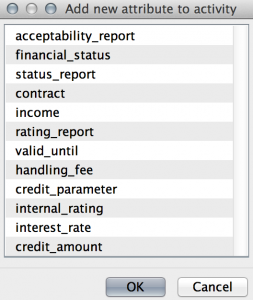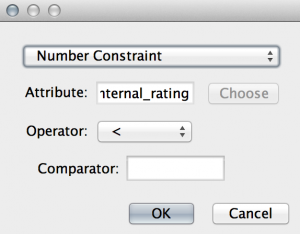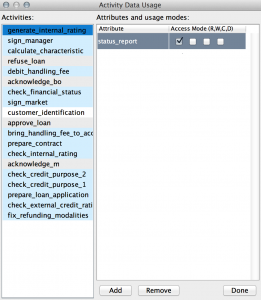The context component contains information on the business setting, the simulation procedure relates to. This includes business activities, subjects executing these activities, data attributes used during process execution and access control permissions for executing activities and obtaining values of data items.
Activities define the different business actions, that can be carried out throughout the simulation procedure such as refusing loan, prepare contract, check external credit rating, etc. The context dialog allows to adjust the considered activities but ensures consistency of context definitions. This means, that the context of a simulation procedure has to contain all activities that can occur in all Petri nets of the corresponding simulation runs.
Activities can be defined or generated. In case a user wants to specify activities explicitly, he can define the different activities by entering a comma-separated list of values. To generate a set of “dummy”-activities, the Generate Activities-dialog allows to specify the number of desired activities together with a name-prefix and -postfix and will generate a set of activities automatically. Again, the consistency of a context is checked when activities are added. This type of defining/generating values also holds for subjects and attributes of a contex
Subjects indicate people involved in the execution of simulation processes. A subject can stand for a human explicitly invoking a process activity or a system “agent” which is executing activities automatically. In either case, the simulation procedure has to know which subject can be assigned to which process activities which have to be defined explicitly with the help of an access control model.
Attributes stand for data elements which are used during process execution. The idea is that each activity uses a (possibly empty) set of data elements when it is executed and each element carries a fixed value during the execution of a process (e.g. the credit amount in a loan application process). Possible values for data elements are defined with the help of data containers (see below). The information which activity used which data elements must be entered by the user (Set Data Usage). Note: A subject is able to execute a process activity, if it (i) has permission to execute the activity and (ii) has permission to access all data elements used by the activity.
Constraints allow users to specify preconditions for the execution of process activities in form of required values of data elements. This influences the generation of process traces in a sense, that only those activities are executed whose constraints are fulfilled. On Petri net level (which is the used meta-model for process models), the set of enabled transitions is reduced according to existing constraints, when the simulation tool decides about the next transition to fire.
The Activity Data Usage dashboard allows users to refer attributes to activities. Thereby the user can define if the attribute is reading (R), writing (W), copying (C) or deleting (D).






